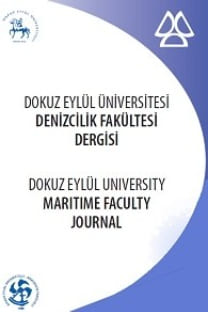GEMİLERDE YAŞAM MAHALLERİNİN DİNLENME KOŞULLARININ DEĞERLENDİRİLMESİ
Ergonomi çalışmaları, işe özel alanlar için yaygın olarak ele alınmıştır. Bu durum, denizcilik sektöründe de çalışmaların odak noktasının köprü üstü ergonomisi olması nedeniyle gözlemlenmektedir. İstatistikler, deniz kazalarının temel nedeninin insan faktörünün bir yansıması olan yorgunluk olduğunu göstermiş, böylece gemideki dinlenme ve dinlenme koşulları hayati bir konu haline gelmiştir. Ancak, literatürde, gemide dinlenme amacıyla kullanılan yaşam mahalleri ve ergonomik koşulları da içeren dinlenme koşulları göz ardı edilmiştir. Bu çalışmanın amacı gemi adamlarının gemideki dinlenme koşullarını ne ölçüde tatmin edici bulduklarını saptamaktır. Bu kapsamda, bir anket çalışması gerçekleştirilmiştir. Bu çalışmanın örneklemi 74 gemi adamından oluşmaktadır. Bulgular, gemi adamlarının konfor algısının değişiklik gösterdiğini işaret etmektedir. Ayrıca, gemi adamlarının medeni durumu ve eğitim düzeylerinin konfor algısı üzerinde belirleyici unsurlar olduğu bulunmuştur.
Anahtar Kelimeler:
Deniz kazaları, yorgunluk, ergonomi, gemideki yaşam mahalleri, dinlenme koşulları
EVALUATION OF THE REST CONDITIONS OF THE ACCOMMODATION AREAS ON-BOARD SHIPS
Ergonomics studies have widely been addressed to the job-specific fields. This situation is also observed in the maritime industry due to the fact that focus point of the studies is bridge ergonomics. Statistics have shown that the main reason for maritime accidents is fatigue as a reflection of human factor, thereby rest and rest conditions on board have become a vital issue. However, in the literature, accommodation areas used for rest on board and their rest conditions including ergonomic criteria have been overlooked. The purpose of this study is to determine the extent to which seafarers find the conditions of the rest areas satisfying. To do this, a survey study has been applied. Through the survey, the perceptions of seafarers of the conditions of the rest areas within the accommodation on board ships have been analyzed. The findings indicate that comfort perception of seafarers varies. Moreover, seafarers’ marital status and education level have been found to be the basic determinants of their comfort perception.
___
- American Bureau of Shipping (ABS), (2016). Guide for Crew Habitability on Ships. Houston.
- Barnett, M.L. and Pekcan, C.H. (2017). The Human Element in Shipping. Encyclopedia of Maritime and Offshore Engineering. 1-10.
- Bridger, R.S. (2003). Introduction to Ergonomics. London: Taylor and Francis.
- Dul. J., and Weerdmeester, B. (2008). Ergonomics for Beginners A Quick Reference Guide (3rd ed.). Florida: CRC Press.
- Fernandez, J.E. (1995). Ergonomics in the Workplace. Facilities, 13(4): 20 – 27.
- Hafez A., (1999). Seafarer’s Social Life and Its Effect on Maritime Safety with Respect to Egyptian Seafarers. Published Master Thesis. World Maritime University.
- Hanzu-Pazara, R., Barsan, E., Arsenie, P., Chiotoroiu, L., Raicu, G. (2008). Reducing of Maritime Accidents Caused by Human Factors Using Simulators in Training Process. Journal of Maritime Research. 5(1): 3-18.
- Health and Safety Executive UK (2018). web site https://www.hse.gov.uk /humanfactors/topics/lighting.htm, 15.03.2018.
- International Labour Organization (ILO), (1970). C133 – Accommodation of Crews (Supplemantary Provisions Convention, 1970 (No.133). https://www.ilo.org/dyn/normlex/en/f?p=NORMLEXPUB: 12100:0::NO::P12100_ILO_CO DE: C133, (Access Date: 13.05.2018).
- International Labour Organization (ILO), (1976). C147 – Merchant Shipping (Minimum Standards) Convention, 1976 (No.147). https://www.ilo.org/dyn/normlex/en/f?p=1000:12100:::NO:12100:P12100_INSTRUMENT_ID:312292, (Access Date: 13.05.2018).
- International Labour Organization (ILO), (2006). Maritime Labour Convention, 2006. https://www.ilo.org/wcmsp5/groups/public/ @ed_norm/@normes/documents/normativeinstrument/wcms_090250.pdf, (Access Date: 13.05.2018).
- Kan, E. and Kişi, H. (2016). Köprüüstü Tasarımı Ergonomik Analizi: Kullanıcı Algısı Üzerine Bir Çalışma. Journal of ETA Maritime Science. 4(2):113-133.
- Kolcubaşı G. Y. (2018). “Evaluation of Rest Conditions of The Accommodation Areas Used for Rest on Board”, Unpublished Master Thesis, Dokuz Eylül Üniversitesi, Sosyal Bilimler Enstitüsü, İzmir. Lozowicka, D. and Kaup, M. (2015). Analysis of the Cause and Effect of Passanger Ship Accidents in the Baltic Sea. Scientific Journals of the Maritime University of Szczecin. 44 (116): 68-73.
- MacLeod, D. (2000). The Rules of Work: A Practical Engineering Guide to Ergonomics. London: Taylor and Francis.
- Oluseye O.O., and Ogunseye O.O. (2016). Human Factors as Determinants of Marine Accidents in Maritime Companies in Nigeria. Journal of Maritime Research. 13(3): 61-68.
- www.egemenoglu.av.tr, (2014). www.egemenoglu.av.tr/F/Root /Pdf/Denizcilik_is_Sozlesmesi_(Maritime_Labour_Convention__MCL_2006)_Hakkinda_inceleme_ve_Degerlendirme.PDF, (Access Date: 13.05.2018).
- ISSN: 1309-4246
- Yayın Aralığı: Yılda 2 Sayı
- Başlangıç: 2009
Sayıdaki Diğer Makaleler
ÇANAKKALE BOĞAZI’NDA MEYDANA GELEN DENİZ KAZALARININ ANALİZİ
Nur Jale ECE, Volkan TOK, İzzettin TEMİZ
COĞRAFİ BİLGİ SİSTEMLERİ KULLANILARAK LİMAN GÜRÜLTÜ KİRLİLİĞİNİN DEĞERLENDİRİLMESİ VE HARİTALANMASI
Ahmed AL QERSHI, Müge BÜBER, Ali Cemal TÖZ
GEMİLERDE YAŞAM MAHALLERİNİN DİNLENME KOŞULLARININ DEĞERLENDİRİLMESİ
Giray Yiğit KOLCUBAŞI, K. Emrah ERGİNER
DENİZ KAZALARININ ÇÖZÜMLENMESİNE GÜNCEL BİR BAKIŞ: FRAM YÖNTEMİ İLE ANALİZ ÖRNEĞİ
